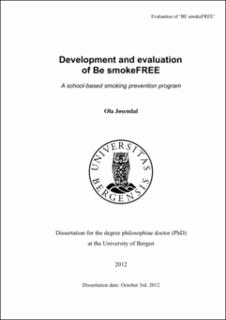| dc.description.abstract | In 1988, approximately 7500 persons in Norway died from smoking-related diseases like heart failure and cancer (Engeland, 1997). Evidence from epidemiology strongly indicates that smoking is the main cause of a number of diseases, for instance lung- and airway diseases. During the second half of the 20’th century, the health hazards from smoking were documented in a steadily increasing body of research (e.g. Royal College of Physicians, 1992).
Based on overwhelming facts, the Norwegian Cancer Society took an initiative to launch a tobacco prevention project in Norwegian secondary schools. The project was based on available knowledge, including relevant theory and methods. The intervention included three components: a classroom programme during secondary school, teacher courses, and parental involvement. Ninety nine Norwegian secondary schools were included in the project, and the schools were divided into four groups: Group A, control, performing traditional antitobacco education; Group B, intervention with all three intervention components; Group C, as B but without teacher courses; Group D, as B but without parental involvement.
Main results:
Article 1: There were no significant differences in smoking habits among the four groups at baseline. The smoking habits in the group that was involved in the most comprehensive intervention (group B) changed more favourably than those of students in the comparison schools over the three follow-up data collections. At the third follow-up, the proportion of students smoking weekly or more in the comparison group was 29.2%, compared with 19.6% in the model intervention group. The proportions of smokers at the last data collection among students in the schools with less comprehensive interventions was lower than among students in the comparison schools, but higher than among students in schools with the most complete intervention. Smoking prevalence in these groups were, however, not significantly different from smoking prevalence in groups A and B. Multilevel multiple logistic regression analyses, comparing changes in smoking habits between students in group B with those among students in the comparison schools (group A), confirmed the conclusion that the comprehensive intervention was the most effective. The findings from this first publication provide reasons for recommending the programme to be implemented for secondary schools all over Norway.
Article 2: The dimensionality of smoking outcome expectancies was the same at both time points (baseline and last follow-up data collection), revealing three components (‘Addicted’, ‘Not harmful’ and ‘Social’). After correction for attenuation, the Pearson’s correlation between T1 and T2 (which in this article means the last data collection) was .41 for the total sumscore, indicating a low to moderate relative stability. When examining smoking expectancy sumscore means by smoking habits at T1 and T2, never smokers were markedly different from the smokers on both occasions. Never smokers scored low on “Social” and “Not harmful”, and high on “Addictive”. All associations were statistically significant (p<.001). The ‘Social’ dimension was the strongest predictor of smoking behaviour both at T1 and T2. One of the outcome expectancy sumscores (‘Addictive’) at T1 predicted smoking habits at T2 after controlling for smoking habits at T1 (p<.01). This predictor was significant also after entering outcome expectancy sumscores at T2 into the model (p<.05). These findings illustrate the importance of emphasizing other outcomes than health related ones when designing intervention programmes for young people.
Article 3: Measurement models were tested for self-efficacy and outcome expectancies modelled as latent variables. Acceptable fit was obtained without introducing any correlated error terms. A series of growth curve models were tested with frequency of smoking across measurement occasions modelled as a dependent latent variable. The intercept corresponds to the level of smoking at baseline while the slope is interpreted as change over time. The unit of change was set to one year. Self-efficacy was defined as a latent variable with all items used as indicators. Outcome expectancy items are divided into three groups, each group being indicators of one latent variable. The three latent variables are “Smoking is social”, “Smoking is addictive” and “Smoking is harmful”.
Model 1 shows a significant difference in slope between intervention group and comparison group (coefficient = -.23; p < .05). Adding gender to the model reduces the coefficient marginally (Model 2). Adding self-efficacy and outcome expectancy sumscores measured at baseline (Models 3-5) increases the size of coefficient. With self-efficacy and outcome expectancies at baseline both included (Model 5), the coefficient is -.29 ( p < .01). Adding first self-efficacy and then outcome expectancy sumscores at the last follow up data collection (Models 6-7) separately to the predictors, reduces the association between group (intervention versus comparison) and slope (change in smoking habits over time) to -.15 and -.10. If both are simultaneously included (Model 8), the unstandardized coefficient goes down to -.13 (not significant), indicating some mediation of programme effects. The most comprehensive model (Model 8) explains 76.4% of the variance in intercept and 94.1% of the variance in slope.
When testing all meditational paths from group (intervention versus control) to change in smoking over time (slope) combined (Sobel’s approximate test), significance was not obtained (p = .39). Estimate of total effect was -.125, while the estimate of all indirect effects combined was -.047 (unstandardized coefficients). This test could not be done on all ten imputed data sets combined. The first imputed data set was chosen for this particular test.
This article provides no clear evidence that self-efficacy and outcome expectancies mediated the effects of the programme on smoking behaviour. | en_US |
